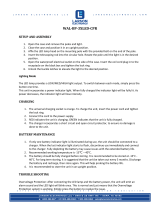
CAUTION
Equipment Misoperation. Check minimum trip values
prior to changing an alternate profile. Failure to do
so may cause misoperation of the recloser under
loadconditions.
T280.1
IMPORTANT
Program all protection profiles. If unused, the alternate
profile should be programmed with the same settings
as the Normal profile. Default settings on the unused
alternate profile can cause unnecessary outages if they
are below normal system requirements.
The control must be programmed with all necessary
operating settings, all alternate profiles, parameters, and
alarms prior to operation with an energized recloser.
ote:N Initial programming of the control is the responsibility
of a qualified technician or engineer familiar with
control functions and programming parameters
required for the specific recloser installation.
ote:N A flashing CONTROL OK LED indicates a problem
with user settings. Default settings will be displayed
under these circumstances, but protection has been
disabled. User protection profile settings must be
reconfigured to enable protection.
When the CONTROL OK LED is flashing, the following
message appears on the LCD display upon power-up:
Protection Disabled. Change Protection Settings.
Press ESC to Clear Message.
As soon as the HMI goes into power save mode
(inactivity for 15 minutes) the message will no longer
display on the LCD, but the CONTROL OK LED will
continue to flash to indicate protection is disabled.
The control must be programmed with the Form 4D ProView
NXG interface software. Refer to Service Information
S280-104-2 Form 4D Microprocessor-Based Recloser Control
Programming Guide for additional information.
Control/recloser compatibility
The Form 4D pole-mount recloser control is adaptable to the
following Eaton Cooper Power series reclosers:
WE*, WVE27, WVE38X, VWE, VWVE27, VWVE38X, VSA12,
VSA16, VSA20, VSA12B, VSA20A, VS012, VS016, NOVA15,
NOVA27, and NOVA38.
Eaton Cooper Power series reclosers manufactured prior
to June 1989 are equipped with Type A bushing current
transformers. These reclosers were designed for use with
Form 2, Form 3, and Form 3A controls. Because the Form 4D
recloser control is designed for use with reclosers equipped
with Type B current-sensing Transformers, reclosers retrofitted
with Form 4D recloser controls should be retrofitted with
Type B current transformers. All Eaton Cooper Power series
reclosers manufactured since June 1989 are equipped with
Type B (1000:1, 1000/500:1, or 2000:1) sensing CTs.
* This control is not compatible with Form 1 Type WE reclosers below s/n
300 and RE reclosers below s/n 400.
Reclosers factory-equipped with Type B sensing CTs are
compatible with all Eaton Cooper Power series recloser
controls (Form 2, Form 3, Form 3A, Form 4A, Form 4C,
FXA, FXB, Form 5, Form 5 LS/UDP, Form 6, and Form 4D
recloser controls), and are identified with the following label
prominently displayed on the recloser sleet hood or the
front of the operator cabinet:
NOTICE
Recloser is equipped with type B sensing cts.
Recloser does not have a battery charger.
The Form 4D recloser control can be used with the old-style
Type A CTs; however, the event recorder and duty cycle
monitor will have limited accuracy for currents above
5000Amps.
Retrofit kits with the new Type B sensing CTs are
available to upgrade reclosers for operation with Form 4D
recloser controls. For additional information, contact your
Eatonrepresentative.
For identification, Table 1 lists the serial number breaks
between old-style Type A and the new-style Type B sensing
CTs. Below this serial number, the recloser is equipped with
the Type A CTs.
ote:N For reclosers shipped prior to June 1989 and not
listed below, contact your Eaton representative with
the recloser type and serial number for verification of
type A or B bushing current transformers.
Table 1. Serial number break for reclosers with type a
sensing CTs
Recloser Below serial number
WE 11199
WVE 3695
VWE 7199
VWVE27 7208
VWVE38 1204
All VSA12, VSA12B, VSA16, VSA20, and VSA20A reclosers are equipped
with Type B Sensing CTs.
All VWVE38X and VWE38X reclosers are equipped with Type B Sensing CTs.
Duty cycle monitor
The Duty Cycle Monitor provides the following duty
cycleinformation:
Measures and records duty for each individual phase in
non-volatile memory.
The recloser duty is measured and stored on the basis of
Current
1. 5
x Number of Operations for Each Phase
(ANSI C37.61).
Readout is based on a percentage of total duty cycle for
each phase.
Duty record can be adjusted or reset if recloser is
changed-out, serviced, etc.
13OPERATION INSTRUCTIONS MN280049EN September 2017
Form 4D Microprocessor-based pole-mount recloser control installation and operation instructions




















